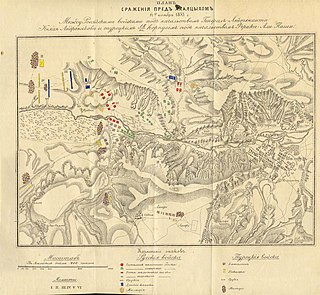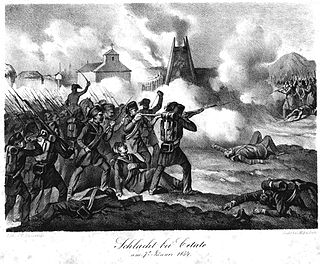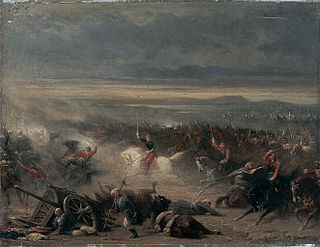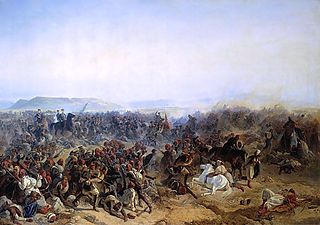 W
WThe Battle of the Alma was a battle in the Crimean War between an allied expeditionary force and Russian forces defending the Crimean Peninsula on 20 September 1854. The allies had made a surprise landing in Crimea on 14 September. The allied commanders, Maréchal Jacques Leroy de Saint-Arnaud and Lord Raglan, then marched toward the strategically important port city of Sevastopol, 45 km (28 mi) away. Russian commander Prince Alexander Sergeyevich Menshikov rushed his available forces to the last natural defensive position before the city, the Alma Heights, south of the Alma River.
 W
WThe Battle of Balaclava, fought on 25 October 1854 during the Crimean War, was part of the Siege of Sevastopol (1854–55), an Allied attempt to capture the port and fortress of Sevastopol, Russia's principal naval base on the Black Sea. The engagement followed the earlier Allied victory in September at the Battle of the Alma, where the Russian General Menshikov had positioned his army in an attempt to stop the Allies progressing south towards their strategic goal. Alma was the first major encounter fought in the Crimean Peninsula since the Allied landings at Kalamita Bay on 14 September, and was a clear battlefield success; but a tardy pursuit by the Allies failed to gain a decisive victory, allowing the Russians to regroup, recover and prepare their defence.
 W
WThe Battle of Akhaltsikhe - the battle that took place on November 24, 1853 near the Akhaltsikh fortress during the Crimean War between the Russian and Ottoman armies.
 W
WThe Battle of Başgedikler - major battle between Russian and Turkish troops during the Crimean War at the Caucasian theater. It happened on December 1 near the village Bashkadyklar, 35 km east of the Turkish fortress Kars. A Russian corps under the command of General Bebutov attacked the Anatolian Turkish army under the command Reis-Akhmet Pasha, who tried to stop the advance of Russian troops to Kars.
 W
WThe Battle of Bomarsund, in August 1854, took place during the Åland War, which was part of the Crimean War, when an Anglo-French expeditionary force attacked a Russian fortress. It was the only major action of the war to take place at Bomarsund in the Baltic Sea.
 W
WThe Siege of Calafat took place in 1854 during the Crimean War. The Russians unsuccessfully besieged the Ottoman army at this place for four months before finally withdrawing.
 W
WThe Battle of Cetate was fought during the Crimean War. In this battle a large Ottoman force under Ahmed Pasha attempted to capture the village of Cetate in Wallachia, controlled by the troops of Colonel Alexander Baumgarten, but were unsuccessful.
 W
WThe Battle of the Chernaya was a battle by the Chornaya River fought during the Crimean War on August 16, 1855. The battle was fought between Russian troops and a coalition of French, Sardinian and Ottoman troops. The Chornaya River is on the outskirts of Sevastopol. The battle ended in a Russian retreat and a victory for the French, Sardinians and Turks.
 W
WThe battle of Choloki took place on 4 June 1854 on the outskirts of village Kakuti in Guria during the Crimean war.
 W
WThe Battle of Eupatoria was the most important military engagement of the Crimean War on the Crimean theatre in 1855 outside Sevastopol.
 W
WThe Battle of the Great Redan was a major battle during the Crimean War, fought between British forces against Russia on 18 June and 8 September 1855 as a part of the Siege of Sevastopol. The French army successfully stormed the Malakoff redoubt, whereas a simultaneous British attack on the Great Redan to the south of the Malakoff was repulsed. Contemporary commentators have suggested that, although the Redan became so important to the Victorians, it was probably not vital to the taking of Sevastopol. The fort at Malakhov was much more important and it was in the French sphere of influence. When the French stormed it after an eleven-month siege that the final, the British attack on the Redan became somewhat unnecessary.
 W
WThe Battle of Inkerman was fought during the Crimean War on 5 November 1854 between the allied armies of Britain, France and Ottoman Empire against the Imperial Russian Army. The battle broke the will of the Russian Army to defeat the allies in the field, and was followed by the Siege of Sevastopol. The role of troops fighting mostly on their own initiative due to the foggy conditions during the battle has earned the engagement the name "The Soldier's Battle".
 W
WThe Siege of Kars was the last major operation of the Crimean War. In June 1855, attempting to alleviate pressure on the defence of Sevastopol, Emperor Alexander II ordered General Nikolay Muravyov to lead his troops against areas of Ottoman interest in Asia Minor. Uniting disparate contingents under his command into a strong corps of 25,725 soldiers, 96 light guns, Muravyov decided to attack Kars, the most important fortress of Eastern Anatolia.
 W
WThe Battle of Kurekdere took place in 1854 as part of the Crimean War. It started when the Ottoman army of Kars marched towards Gyumri to attack the Russian force commanded by General Vasili Bebutov, already weakened with detachments. The battle was related with great spirit and the defeat of the Ottoman army by the Russian forces.
 W
WThe Battle of Malakoff was a French attack against Russian forces on the Malakoff redoubt and its subsequent capture on 8 September 1855 as a part of the Siege of Sevastopol during the Crimean War. The French army under General MacMahon successfully stormed the Malakoff redoubt, while a simultaneous British attack on the Redan to the south of the Malakoff was repulsed. In one of the war's defining moments, the French zouave Eugène Libaut raised the French flag on the top of the Russian redoubt. The Battle of Malakoff resulted in the fall of Sevastopol on 9 September, bringing the 11-month siege to an end.
 W
WThe Battle of Oltenița was fought on 4 November 1853 and was the first engagement of the Crimean War. In this battle an Ottoman army under the command of Omar Pasha was defending its fortified positions from the Russian forces led by General Peter Dannenberg, until the Russians were ordered to withdraw. The battle was indecisive, with both sides claiming victory. The Russian attack was called off just when Dannenberg's troops reached the Ottoman fortifications, and they moved back in full order, yet unwillingly. The Turks held their positions, but their success was insignificant, and they retreated afterwards.
 W
WThe siege of Sevastopol lasted from October 1854 until September 1855, during the Crimean War. The allies landed at Eupatoria on 14 September 1854, intending to make a triumphal march to Sevastopol, the capital of the Crimea, with 50,000 men. The 56-kilometre (35 mi) traverse took a year of fighting against the Russians. Major battles along the way were Alma, Balaklava, Inkerman, Tchernaya, Redan, and, finally, Malakoff. During the siege, the allied navy undertook six bombardments of the capital, on 17 October 1854; and on 9 April, 6 June, 17 June, 17 August, and 5 September 1855.
 W
WThe Siege of Silistra took place during the Crimean War in which Russian forces besieged the Ottoman fortress of Silistra. Sustained Ottoman resistance allowed French and British troops to build up a significant army, landing in nearby Varna. After six weeks of siege the Russian forces, although about to storm the fortress, were ordered to lift the siege and retreat from the area, thus ending the Danubian phase of the war.
 W
WThe Battle of Suomenlinna was fought on 7–8 August 1855 between Russian defenders and a joint British/French fleet during the Åland War. It was a part of the Crimean War.
 W
WThe Thin Red Line was an episode in the Battle of Balaclava on 25 October 1854, during the Crimean War. In this incident, around 500 men of the 93rd, aided by a small force of 100 walking wounded, 40 detached Guardsmen, and supported by a substantial force of Turkish infantrymen, led by Sir Colin Campbell, fired at the Russian cavalry. Previously, Campbell's Highland Brigade had taken part in actions at the Battle of Alma and the Siege of Sevastopol. There were more Victoria Crosses presented to the Highland soldiers at that time than at any other. The event was lionised in the British press and became an icon of the qualities of the British soldier in a war that was arguably poorly managed and increasingly unpopular.